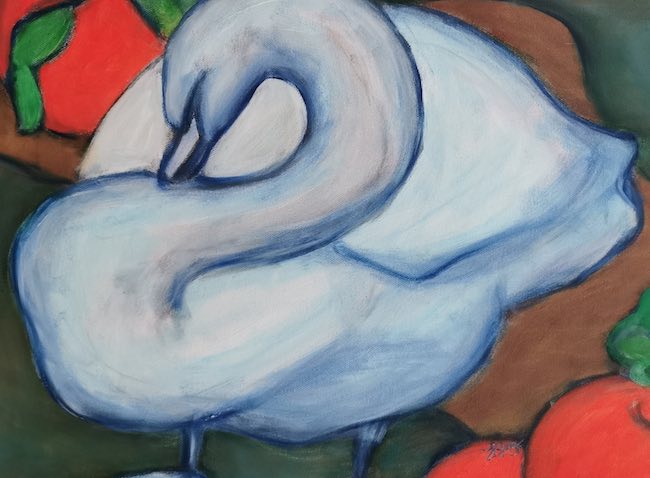L’arte contemporanea si spinge spesso verso linguaggi con cui poter dare risalto all’essenziale all’interno di un mondo caotico e staccato dalla semplicità e l’immediatezza della natura, esplorando in modo lucido la realtà per poi imprimere sulla tela le emozioni suscitate dal caos che esce da quell’osservazione; in altri casi invece viene utilizzato un approccio disincantato, conscio dei difetti di forma e dunque cercando una visione lucida e analitica di tutto ciò che appartiene al vissuto. E poi vi sono artisti che, pur essendo perfettamente calati nella contemporaneità con tutte le sue complicazioni, scelgono di raccontare un universo differente, quasi incantato in cui la semplicità e la purezza si pongono come mezzo per oltrepassare i confini del quotidiano ed evadere verso un’armonia in grado di trasportare l’individuo in una dimensione sospesa tra sogno e realtà.
Il movimento artistico dell’Espressionismo nacque dai primi semi teorici di quel gruppo avanguardista francese dei primissimi anni del Novecento denominato Fauves che affermò con forza l’esigenza del distacco dall’estetica e l’armonia delle immagini riprodotte, di quell’inseguimento verso la bellezza e l’attinenza alla realtà che apparteneva al poco precedente Realismo e al coevo Impressionismo; ciò che doveva emergere era l’emozione, troppo a lungo lasciata in secondo piano rispetto alla perfezione armonica, in maniera necessariamente forte, eccessiva, travolgente allo stesso modo del manifestarsi delle sensazioni interiori. Le tele di Matisse, di Derain e di de Vlaminck erano contraddistinte pertanto da colori intensi, violenti, al punto di guadagnarsi l’appellativo di bestiali, Fauves in francese. Nel momento in cui tutti gli artisti che decisero di sposare la filosofia della supremazia dell’emozione sulla forma esteriore decisero di unirsi, definire le linee guida, seppure modificate sulla base del paese di appartenenza degli autori, sorse il movimento dell’Espressionismo che assunse connotazioni differenti secondo il carattere, la comunicatività e l’inclinazione degli appartenenti al gruppo. Le atmosfere cupe, tempestose o dissacranti del nord Europa, come la disperazione e l’inquietudine delle opere di Edvard Munch e di Emil Nolde, sembravano contrapporsi alle atmosfere sensuali e quasi deformi dell’Espressionismo austriaco di Egon Schiele e Oskar Kokoshka o alla lucida follia e il tendere verso la manifestazione dei propri fantasmi interiori delle opere luminose e intense di Vincent Van Gogh. E poi vi furono i sognatori, quegli artisti che cercavano, e trovarono, una via d’uscita dall’instabilità esistenziale di quell’impetuoso periodo storico a cavallo tra le due guerre, un luogo più o meno reale dove rifugiarsi per cercare quella serenità e quella felicità che nella realtà sembravano irraggiungibili. Le ambientazioni giocose, leggere e serene di Marc Chagall rendevano l’Espressionismo un fantastico viaggio per evadere dalla realtà quanto il periodo polinesiano di Paul Gauguin che trovò nelle isole del Pacifico la pace e l’armonia che tanto cercava; spirituali ed evanescenti le opere del primo quanto esoticamente serene e rilassanti quelle del secondo, entrambi grandi maestri di uno stile che continua a evolversi e ad adattarsi alle sensibilità e alle interiorità degli artisti contemporanei.
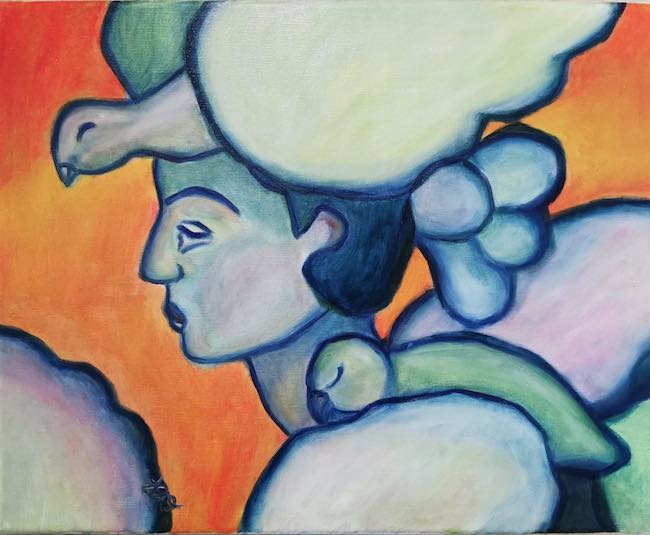
L’austriaca Irene Bergner-Oberndorfer trova proprio in questa corrente pittorica la modalità espressiva più affine alla sua personalità, al suo bisogno di trasmettere emozioni lasciando emergere un grande amore per il mondo animale, per l’importanza che il contatto con l’uomo riveste ma anche per il simbolismo che si cela dietro ogni esponente della fauna domestica, quella più vicina, quella più ammirabile anche nella quotidianità. Il tratto pittorico è definito e contraddistinto dai contorni netti facendo propria una delle principali linee guida del movimento, da tonalità piene e nette, quasi a sottolineare la tendenza a idealizzare le immagini narrate, come se l’artista fosse alla ricerca di un luogo verso cui fuggire, in cui rifugiarsi, tanto quanto avevano fatto Chagall e Gauguin, nella dimensione di un mondo migliore, più puro, meno segnato da eventi e circostanze che inevitabilmente minano la delicatezza interiore di un animo sensibile.
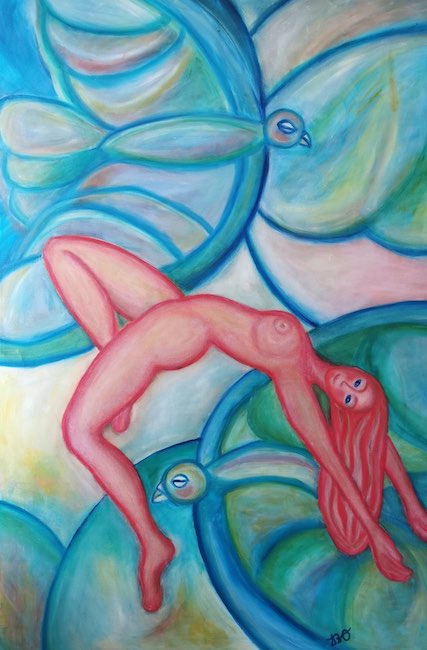
Gli animali di cui racconta Irene Bergner-Oberndorfer sono evocativi di un equilibrio diverso, di una possibilità per l’uomo di sentirsi sollevato da una presenza che nulla detiene delle tristezze, delle ansie e delle brutture che molto spesso l’arrivismo e la prepotenza umana portano con sé; raccontando degli uccelli, metafora della possibilità di scelta tra il restare e il volare via, l’artista ne narra anche la naturalezza, l’immagine allegorica che essi portano con sé secondo l’immaginario comune ma anche secondo quello della Bergner stessa. Le atmosfere sono quelle di una fiaba idilliaca che non ha una specifica collocazione, gli animali potrebbero essere ovunque o in alcun luogo, ma attraverso la quale ciò che emerge è una sensazione di pace, di equilibrio, di astrazione dalla contingenza per lasciarsi trasportare verso la dimensione del sogno. Quella natura che tanto ha affascinato gli artisti di ogni epoca, qui diventa una meravigliosa evasione, un desiderio di sinergia e armonizzazione totale con quell’elemento spontaneo e puro che prende l’osservatore e lo conduce letteralmente in quell’universo parallelo che costituisce un ideale verso cui l’essere umano dovrebbe essere capace di tendere.
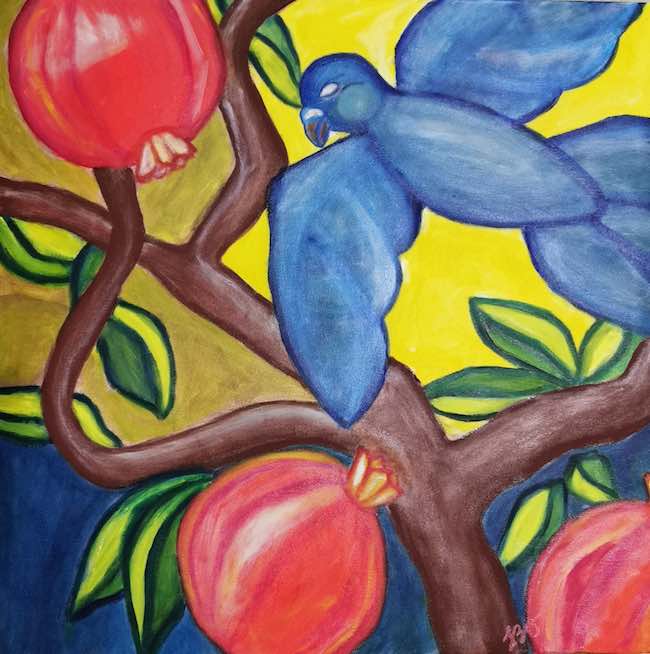
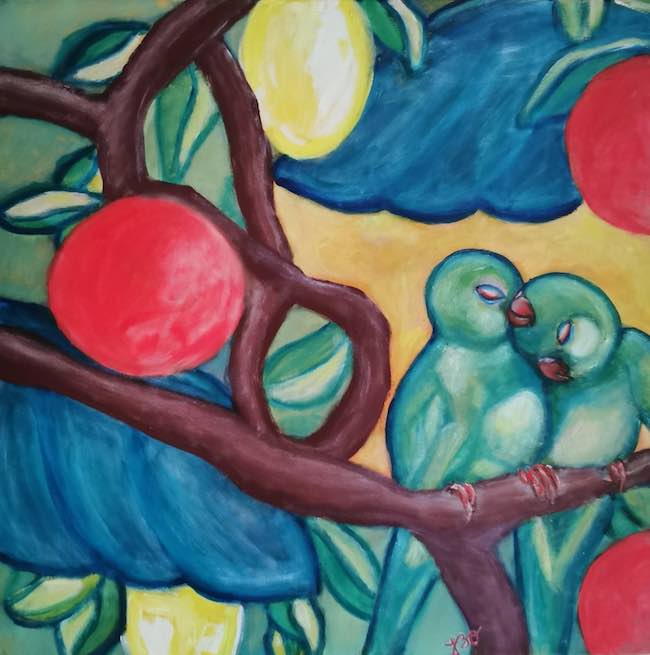
Le opere Paradise 1 e Paradise 2 sono state concepite e realizzate in un momento particolare, di solitudine provocata dall’evento pandemico che ha gettato un’ombra scura sulla vita delle persone di tutto il mondo e dunque riprodurre una colomba e due pappagallini ha costituito per Irene Bergner-Oberndorfer un modo per esorcizzare l’oscurità di quel periodo e cercare una luce nuova, di speranza, di gioia e di spontaneità grazie alla bellezza di quei piccoli animali, tanto delicati quanto privilegiati per la loro capacità di volare, sfuggendo all’occorrenza da luoghi in cui non si sentono al sicuro o a proprio agio. Inconsciamente l’artista svela il suo desiderio di essere capace di spiccare a sua volta il volo allontanandosi dall’ombra incombente e tendere verso un mondo parallelo dove tutto l’accaduto avrebbe potuto essere dimenticato. Sembra quasi un Paradiso perduto quello della Bergner, con chiaro riferimento a John Milton non nella parte più legata all’episodio biblico della caduta di Adamo ed Eva, quanto per la bellezza e la pace di tutto ciò che a causa del peccato originale è stato perduto.
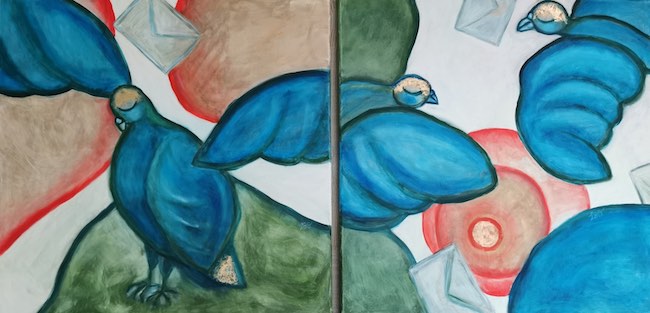
Il dittico Friedensbotschaft (Messaggio di pace) è stato invece ispirato dallo scoppio della guerra in Ucraina, appare come un desiderio che tutto finisse presto e i governanti, gli uomini che decidono delle sorti dei loro popoli, potessero fermarsi e compiere la scelta migliore, cercando di tornare a quella bellezza primordiale costituita dall’immediatezza e dall’armonia di un equilibrio, quello del mondo naturale e animale, che non conosce violenza, sopraffazione, bensì solo la legge della vita. Le colombe sembrano voler afferrare con il loro becco le piccole lettere contenenti richieste inespresse di cessare ogni combattimento per lasciar emergere il buon senso e l’amore inteso in senso universale, pur non riuscendovi, quasi come se l’arrivismo e l’avidità umana fosse un ostacolo a quel messaggio. Un amore così profondo per gli uccelli non poteva non esprimersi anche attraverso l’immagine del più regale, maestoso e affascinante dei volatili, il cigno, simbolo di purezza, di saggezza, di tenerezza, che ha coinciso per la Bergner con la scoperta dello stile più affine a sé, quando ha cominciato ad avvertire l’esigenza di usare tela e pennelli per esprimere un suo sé interiore che fino a quel momento era rimasto in silenzio.
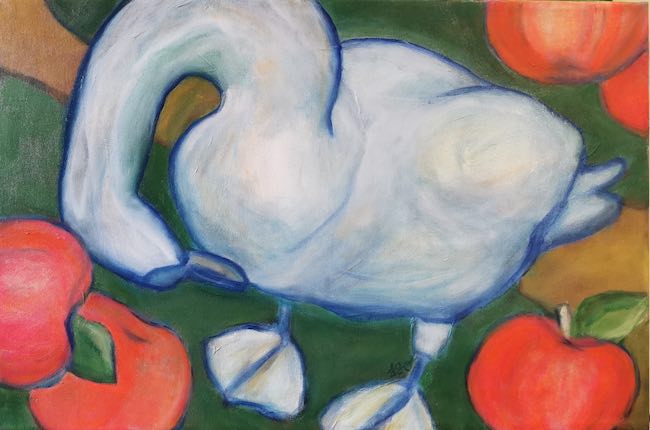
Nella tela Schwäne (Cigno) lo ritrae in un momento di solitudine, di rilassatezza mentre si pulisce le piume, come se niente intorno costituisse un pericolo perché nel mondo da fiaba di Irene Bergner-Oberndorfer tutto è in perfetta armonia, in delicato equilibrio necessario a realizzare quell’universo chimerico che rappresenta il desiderio nascosto dell’essere umano; l’artista sembra suggerire che in fondo tutto dipende dall’approccio che si sceglie di avere e che il sogno, l’ideale, è molto più a portata di mano di quanto l’uomo contemporaneo possa immaginare.
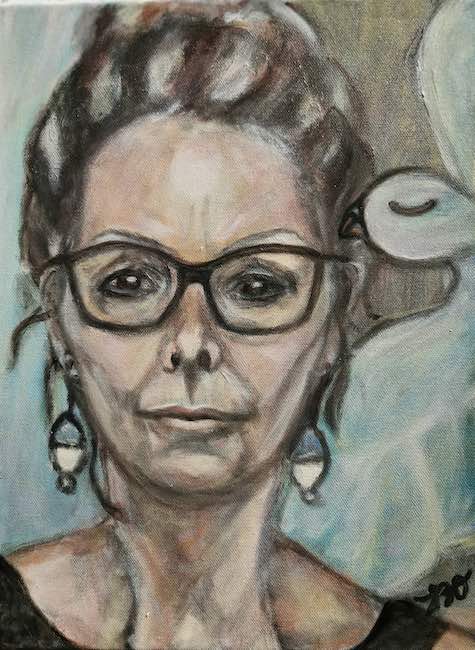
Irene Bergner-Oberndorfer ha studiato presso la Leonardo Art Academy Mattsee-Salzburg, ha all’attivo varie mostre dal 2014 in Austria e Germania; è membro della Palette Artists Association e dell’associazione artistica Artfactory-Graz. Nel 2021 è stata ammessa all’Associazione professionale degli artisti visivi in Austria e nel 2022 presso l’AEA European Art Circle.
IRENE BERGNER-OBERNDORFER-CONTATTI
Email: irene.bergner@chello.at
Sito web: www.irenebergner.net
Facebook: https://www.facebook.com/irene.bergner.1
Instagram: https://www.instagram.com/bergnerirene/
The Expressionism by Irene Bergner- Oberndorfer, evoking an ideal world in perfect harmony
Contemporary art often pushes towards languages with which is possible to emphasise the essential within a chaotic world detached from the simplicity and immediacy of nature, lucidly exploring reality and then imprinting on the canvas the emotions aroused by the chaos that emerges from that observation; in other cases, instead, a disenchanted approach is used, aware of the flaws of form and therefore seeking a lucid and analytical vision of everything that belongs to experience. And then there are artists who, despite being perfectly immersed in the contemporary world with all its complications, choose to narrate a different, almost enchanted universe in which simplicity and purity are posed as a means of transcending the boundaries of the everyday and escaping towards a harmony capable of transporting the individual into a dimension suspended between dream and reality.
The artistic movement of Expressionism was born from the first theoretical seeds of that French avant-garde group of the very first years of the 20th century known as the Fauves, who strongly affirmed the need for detachment from the aesthetics and harmony of reproduced images, of that pursuit towards beauty and relevance to reality that belonged to the slightly earlier Realism and the coeval Impressionism; what had to emerge was emotion, for too long left in the background compared to harmonic perfection, in a way that was necessarily strong, excessive, overwhelming in the same way as the manifestation of inner sensations. The canvases of Matisse, Derain and de Vlaminck were therefore characterised by intense, violent colours, to the point of earning them the appellation bestial, Fauves in French. When all the artists who decided to espouse the philosophy of the supremacy of emotion over external form decided to unite, defining guidelines, albeit modified according to the country of origin of the authors, arose the Expressionism movement, which took on different connotations according to the character, communicativeness and inclination of the group members. The gloomy, stormy or desecrating atmospheres of northern Europe, such as the despair and restlessness of the works of Edvard Munch and Emil Nolde, seemed to contrast with the sensual and almost deformed atmospheres of the Austrian Expressionism of Egon Schiele and Oskar Kokoshka or the lucid madness and the tendency towards the manifestation of one’s inner ghosts of the luminous and intense paintings of Vincent Van Gogh. And then there were the dreamers, those artists who sought, and found, a way out of the existential instability of that impetuous historical period between the two wars, a more or less real place where they could take refuge to seek that serenity and happiness that seemed unattainable in reality. Marc Chagall’s playful, light and serene settings made Expressionism a fantastic journey to escape from reality, just as much as Paul Gauguin’s Polynesian period, when he found in the Pacific islands the peace and harmony he sought so much; spiritual and evanescent the paintings of the former as exotically serene and relaxing those of the latter, both were great masters of a style that continues to evolve and adapt to the sensibilities and interiorities of contemporary artists.
The Austrian artist Irene Bergner- Oberndorfer finds in this pictorial current the expressive mode most akin to her personality, to her need to transmit emotions, allowing a great love for the animal world to emerge, for the importance of contact with man, but also for the symbolism concealed behind each exponent of domestic fauna, the closest, the most admirable even in everyday life. The pictorial stroke is defined and characterised by sharp outlines, making one of the main guidelines of the movement, by full and sharp tones, almost as if to emphasise the tendency to idealise the images narrated, as if the artist were searching for a place to escape to, to take refuge in, just as Chagall and Gauguin had done, in the dimension of a better, purer world, less marked by events and circumstances that inevitably undermine the inner delicacy of a sensitive soul. The animals that Irene Bergner- Oberndorfer tells about are evocative of a different balance, of a possibility for man to feel relieved by a presence that holds nothing of the sorrows, anxieties and ugliness that human arrivism and arrogance very often bring with them; in telling of birds, a metaphor for the possibility of choosing between staying and flying away, the artist also narrates their naturalness, the allegorical image that they carry with them according to the common imagination but also to Bergner’s own. The atmospheres are those of an idyllic fairy tale that has no specific location, the animals could be anywhere or nowhere, but through which what emerges is a feeling of peace, of equilibrium, of abstraction from contingency to let oneself be transported towards the dimension of dreams. That nature that has so fascinated artists of all ages, here becomes a wonderful escape, a desire for synergy and total harmonisation with that spontaneous and pure element that takes the observer and literally leads him into that parallel universe that constitutes an ideal towards which human beings should be able to strive.
The artworks Paradise 1 and Paradise 2 were conceived and realised at a particular time of loneliness caused by the pandemic event that cast a dark shadow over the lives of people all over the world, and so reproducing a dove and two parrots was a way for Irene Bergner-Oberndorfer to exorcise the darkness of that period and seek a new light, of hope, joy and spontaneity thanks to the beauty of those small animals, as delicate as they are privileged for their ability to fly, escaping when necessary from places where they do not feel safe or comfortable. Unconsciously, the artist reveals her desire to be able to fly away from the looming shadows and tend towards a parallel world where everything that happened could be forgotten. It almost looks like a Paradise Lost that of Bergner’s, with clear reference to John Milton, not in the part more related to the biblical episode of the fall of Adam and Eve, but for the beauty and peace of all that was lost because of original sin. The diptych Friedensbotschaft (Message of peace) was instead inspired by the outbreak of war in Ukraine, appearing as a wish that everything would soon come to an end and that the rulers, the men who decide the fate of their peoples, could stop and make the best choice, trying to return to that primordial beauty constituted by the immediacy and harmony of a balance, that of the natural and animal world, which knows no violence, no overpowering, but only the law of life.
The doves seem to want to grasp with their beaks the small letters containing unexpressed requests to cease all fighting in order to let common sense and love, understood in a universal sense, emerge, although they fail to do so, almost as if human arrivism and greed were an obstacle to that message. Such a profound love for birds could not fail to be expressed through the image of the most regal, majestic and fascinating of volatiles, the swan, a symbol of purity, wisdom and tenderness, which coincided for Bergner with the discovery of the style most suitable to her, when she began to feel the need to use canvas and paintbrushes to express an inner self that had hitherto remained silent. In the canvas Schwäne (Swan) she portrays him in a moment of solitude, of relaxation as he cleans his feathers, as if nothing around him constituted a danger because in Irene Bergner- Oberndorfer’s fairytale world everything is in perfect harmony, in the delicate balance necessary to realise that chimerical universe that represents the hidden desire of the human being; the artist seems to suggest that in the end everything depends on the approach one chooses to have and that the dream, the ideal, is much more within reach than contemporary man can imagine. Irene Bergner- Oberndorfer studied at the Leonardo Art Academy Mattsee-Salzburg, has several exhibitions to her credit since 2014 in Austria and Germany; she is a member of the Palette Artists Association and the art association Artfactory-Graz. In 2021 she was admitted to the Professional association of visual artists in Austria and in 2022 to the AEA European Art Circle.


